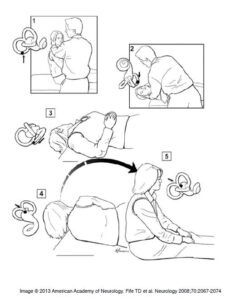Causes of dizziness or vertigo in Spotsylvania can be a very concerning and may lead many people to visit the ER for evaluation. There can be many reasons why someone can become dizzy and can be evaluated by a specialist like a chiropractic orthopedist. The causes of dizziness can be signs of disease in any of the systems that create our body’s awareness of where we are in space. The most common being BPPV or benign paroxysmal positional vertigo.
Balance is maintained by three major systems that create the equilibrium triad. The first of the three are the eyes or visual input that is telling the body where we are in relation to what we see, the second the vestibular system in the inner ear that picks up our changes in position through three semicircular canals which deal with angular head acceleration and two smaller organs called the saccule and utricle which tell us information on changes to the head in relation to gravity. The third is the neck region which has many different sensory receptors that based of of stretching these tissues tells the vestibular system which way the body is moving in space.
Dizziness begins when any of the three above mentioned areas (visual gaze, vestibular system or inner ear, neck joints and muscles) are affected by some degree of dysfunction or disease.
What is dizziness or vertigo in Spotsylvania
Dizziness can be described as a sensation of not being able to sense the body’s position in space. It can lead to balance disturbances and injury from fall. There are many types of dizziness. The first you may have heard of which is called vertigo. This type of dizziness is associated with a sense of spinning whether it be the individual feels like they are the one spinning termed subjective dizziness, or that the surroundings are spinning termed objective dizziness. This type of dizziness is seen commonly in conditions like inner ear injury, migraine, head injury, and viral infections.
Another form of dizziness is called the near-faint dizziness, or pre-syncope. This type of dizziness has to do with blood flow and can be further categorized as orthostatic hypotension, vasovagal response, or be a product of cardiac output, or hyperventilation. There can be accompanied by short term loss of vision or hearing as the individual gets closer to fainting.
Disequilibrium can be one of the causes of dizziness or vertigo and can include may different systems. This can be seen in the aging population or in population where changes to the brain are occurring or spinal cord which leads to the inability of the joints to sense positional changes called proprioception. This can be seen in Parkinson’s disease, diabetes, and cervicogenic dizziness. This condition is not normally seen with nausea and vomiting.
Visually induced dizziness is one that most of us have experiences once in our lifetime. This can happen when changes to corrective lenses are made. Until the brain accommodates a sense of unsteadiness is felt.
Other causes of dizziness or vertigo in Spotsylvania, would include anxiety, drug induced, hypoglycemic, ocular dizziness, and a few others. Some of these go away over time and others .
What could be causes of dizziness or vertigo in Spotsylvania
The key to diagnosis is symptoms. There are certain things you need to pay attention to while your bout of vertigo is happening. The first is what position are you in or did you move into to create the vertigo? How long did it take for the dizziness to start, and most importantly, how long did the dizziness or vertigo last? Also pay attention to how long it takes for the vertigo to get its worst and then subside. Have you been sick recently? Also you will need to pay attention to any loss of hearing or ear ringing.
The time it takes for your dizziness or vertigo to begin is called the latency period. Ringing in the ears is also called tinnitus, and paying attention to whether you have any of these will help your clinician on key tests and procedures that will get you closer to the correct diagnosis and proper treatment.
What are some of the most common causes of dizziness or vertigo
When talking about common causes of dizziness or vertigo we include BPPV or benign paroxysmal positional vertigo, and cervicogenic dizziness or vertigo.
BPPV or benign paroxysmal positional vertigo in Spotsylvania
The most common causes of dizziness or vertigo is BPPV, or benign paroxysmal positional vertigo. There are certain physical exam tests that can be performed to rule in or out this condition by seeing a specialist like a chiropractic orthopedist. BPPV is a problem of becoming dizzy with certain movements like rolling over in bed.
This happens from little stones from the saccule, a little organ in the inner ear that tells our brain where our horizon is, becoming lose and entering one of the three semicircular canals where they do not belong. When this happens the little crystal that is now in the canal called a canalith, can create movement of the fluid in the canal (endolymph) as it precipitates or falls to the bottom of the canal via gravity. This causes the canal to pickup angular movement of the head when in reality there is no movement. This can cause dizziness that take 5-20 seconds to begin and usually subsides in less than 60 seconds.
Some of the key signs of BPPV include: dizziness worse with changes in position like rolling over in bed. A latency period between when you made the movement and onset of the dizziness. Dizziness is short lived but strong anywhere from 15-30 seconds. The vertigo or dizziness will fatigue with continued repeated posturing in the offending position. A condition of rapid eye movements that beat back and forth called nystagmus, which also fatigues out.
BPPV can affect any of 3 canals: anterior, posterior, horizontal canal. The most commonly affected would be the posterior canal, second the horizontal canal, and lastly or least frequent the anterior canal. The posterior canal has been seen as the most common likely due to gravity and position. Posterior canal BPPV is seen in around 85-90% of BPPV cases.
How to test for BPPV
Testing for the different BPPV types are done with specific maneuvers that can be done by your chiropractic orthopedist to identify which canal is affected. These maneuvers involve placing your head into certain positions that aim to move the calcium carbonate crystals in the semicircular canal to induce your symptoms. Care is needed to make sure the position is held long enough as to allow the latency period to expire. Nausea and vomiting can be common symptoms of BPPV and could happen during any of these repositioning procedures.
BPPV is not a serious diagnosis and can be helped with certain healing maneuvers that you can perform in the comfort of your own home. One of the most commonly prescribed is the Epley’s maneuver and is curative in posterior canal BPPV in 85% of the cases. As for BPPV as a whole one third of patients typically remits at 3 weeks and vast majority at 6 months. Less than 1% of patients ever require surgery.

The use of the Epley’s maneuver. Used commonly in posterior canal BPPV. One of the causes of dizziness or vertigo.
Cervicogenic dizziness or vertigo
This condition is common in those that have neck dysfunctions like facet syndrome, cervical degeneration, and whiplash injury. This type of vertigo or dizziness is different than the others because it doesn’t involve the vestibular system directly. The neck is an area where a lot of proprioceptive input is relayed to the balance system through stretch receptors in the muscles and ligaments. The neck has the highest concentration of these receptors more than any in any other part of the body and helps maintain normal posture or balance.
Individuals with this type of condition typically have a history of motor vehicle accidents or sports injuries that damage these receptors. They will also notice a sense of dizziness or vertigo with sustained postures, neck pain, or muscle tightness. Can feel like they are falling or just “off balance.”
This type of dizziness or vertigo seems to be caused by the changes to the upper cervical regions. This type of dizziness or vertigo is particularly responsive to manual spinal manipulative therapy that delivers a small thrust to the area to increase proprioceptive input to the brain and in doing so reducing the muscle tone or tightness. This can be performed by a specialist like a chiropractic orthopedist who can effectively rule out any other causes of dizziness.
Less common causes of dizziness or vertigo in Spotsylvania
Other conditions that are not as common can also be causes of dizziness or vertigo. Some of these include Meniere’s disease, vestibular neuronitis, and labyrinthitis.
Meniere’s disease
This disease is caused by an increase in the inner ears fluid called endolymph. As this pressure increases hearing can become impaired and most of these patients have a feeling of ear pressure. Ringing in the ear is very common as well, this is called tinnitus. It has been recognized that there is a triad of symptoms: vertigo, hearing loss, tinnitus. The length of vertigo episode is important as Meniere’s attacks typically peak in a few minutes and subsides over a matter of hours.
Meniere’s typically occurs in three stages. stage one, sudden unpredictable attacks of vertigo with possible hearing loss that may revert back to normal. Stage two which can be seen as continuing attacks of vertigo that become less severe however the hearing loss typically gets worse this is termed the “classical” stage. Stage three, which vertigo episodes become far less prevalent but may leave the individual with residual balance problems, hearing loss, or tinnitus.
One of the major things that differentiates this condition from BPPV is the hearing loss that accompanies this condition.
Labyrinthitis
This can be caused by a bacterial infection or viral infection, as well as head injury, stress, allergy, medication use, and a condition called cholesteatoma.
With this disorder symptoms typically peak within 24 hours and get better gradually after that. This typically resolves on its own over a course of two to three weeks and can last longer in the older population
Vestibular neuronitis
This is caused by direct injury to the vestibular nerve and can resolve on its own over a few weeks. This is typically thought to be brought on by viral infection possibly from upper respiratory infection or common cold. The progression of dizziness or vertigo is sudden and begins to resolve over the next few days. It is seen as a reactivation of a dormant herpes infection in what is called the Scarpa’s ganglion affecting the superior division of the vestibular nerve. Because this affect the vestibular nerve, hearing not affected and can be key in differentiating it from labyrinthitis.
Other conditions that can cause dizziness or vertigo
These conditions fall into the category of pre-syncope or near faint disorders. The ones we will cover are vasovagal syncope, carotid sinus syncope, and orthostatic hypotension.
Vasovagal syncope
When talking about causes of dizziness or vertigo, we have to investigate blood flow issues. Vasovagal syncope occurs when there is a large reduction in brain blood flow. You usually see these types of fainting when someone has a fear of needles and faints after a lab draw. You may also have this occur when there is a lot of pain, fear, alcohol intoxication, prolonged standing, or dehydration. Symptoms of this condition would be changes in skin tone or clamminess, tunnel vision, trouble hearing, and nausea. This type of dizziness while usually harmless can be quite distressing. Recovery is normally rapid and occurs within minutes of the faint.
Carotid sinus syncope
This condition relates to the carotid artery in the neck region and can be caused by direct compression of the area by a neck-tie or extending the neck to shave. The loss of consciousness comes from a transient lack of blood flow. Most common cause is from cardiovascular disease, and possible blood pressure medication problems. Unlike the other types of faint we’ve mentioned, this type does not typically have symptoms of sweating, changes in skin tone like clamminess, or nausea.
Orthostatic hypotension
This condition happens when lightheadedness or faint occurs within two to five minutes of standing. It is caused by many things like untreated diabetes, dehydration, medications, neurologic disease like parkinsons, and Addison’s disease.
Symptoms are directly related to changes in position like standing up. These include blurred vision, leg weakness or buckling, dizziness, and fainting. Symptoms tend to get better quickly. Treatment for the condition can be done to correct the underlying cause if identified like dehydration, diabetes, avoiding alcohol, avoiding excessive heat, and reviewing medications.
If you are experiencing symptoms or trying to figure out possible causes of dizziness or vertigo in Spotsylvania or Fredericksburg consider seeing a specialist like a chiropractic orthopedist to get evaluated today.





